


The article emphasizes nine essential biomedical devices that are pivotal for clinical research, elucidating their roles in patient care and data collection. Each device, including blood pressure cuffs, glucometers, and pulse oximeters, is examined for its critical importance in monitoring health metrics, enhancing treatment outcomes, and facilitating research. This exploration underscores the devices' vital contributions to advancing medical knowledge and optimizing patient management.
The landscape of clinical research is rapidly evolving, propelled by innovative biomedical devices that significantly enhance patient care and streamline data collection. From blood pressure cuffs to remote monitoring tools, these devices are pivotal in advancing medical knowledge and improving health outcomes.
However, as technology progresses, pressing questions emerge regarding the effectiveness and accessibility of these tools across diverse populations.
What essential biomedical devices do researchers rely on, and how do they shape the future of clinical studies? This inquiry underscores the critical intersection of technology and healthcare, inviting further exploration into the Medtech landscape and its role in overcoming key challenges.
bioaccess® leads the way in research by harnessing the regulatory speed of Latin America, the diverse patient populations in the Balkans, and Australia's efficient pathways to secure ethical approvals in an impressive 4-6 weeks. This accelerated process empowers Medtech, Biopharma, and Radiopharma innovators to expedite their research studies, achieving enrollment rates that are 50% faster than those in traditional markets.
With over 15 years of specialized expertise, bioaccess® offers tailored solutions for early-phase studies, facilitating the rapid and efficient market entry of examples of biomedical devices. As the realm of medical research continues to evolve, bioaccess® remains steadfast in its commitment to driving innovation and enhancing patient outcomes through its agile approach.
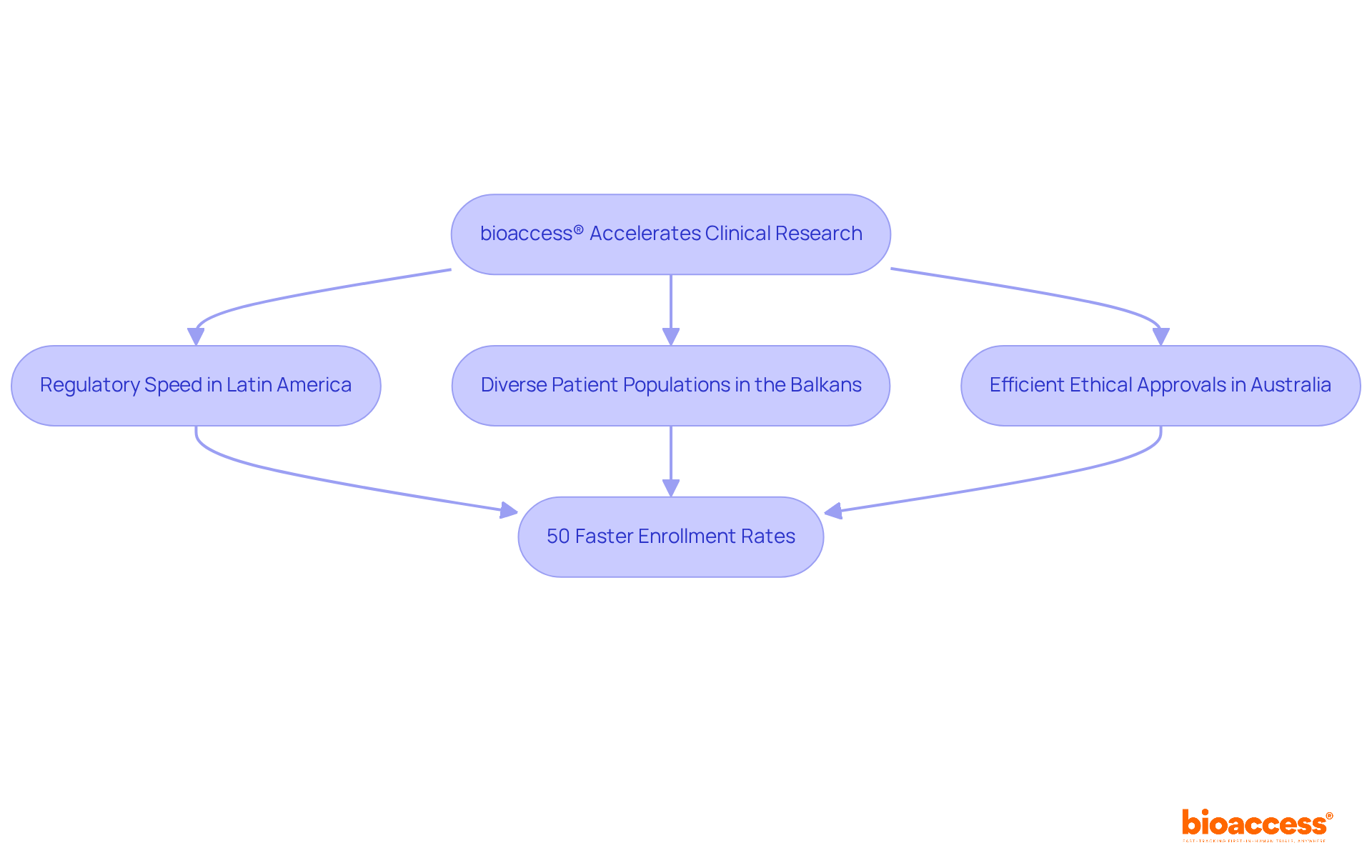
The blood pressure cuff stands as an indispensable instrument within the clinical setting, vital for measuring arterial pressure and facilitating the diagnosis and management of hypertension. This apparatus functions by inflating around the upper arm, temporarily obstructing blood flow, and subsequently measuring the pressure as the cuff deflates. Accurate readings are paramount, as they directly influence treatment plans and patient outcomes. Indeed, consistent observation can significantly reduce the risk of serious complications, such as heart attacks and strokes, underscoring the tool's importance in both research and practice.
In 2025, advancements in blood pressure cuff technology have led to enhanced accuracy rates, with numerous instruments achieving over 95% precision in clinical environments. This level of precision is crucial for effective hypertension management, particularly given that 52.6% to 55.8% of adults aged 20 years and older exhibit elevated blood pressure or stage 1 hypertension. Numerous studies demonstrate that regular observation with reliable devices can result in better control of blood pressure levels. For instance, healthcare providers have effectively utilized blood pressure cuffs to implement tailored hypertension management strategies, resulting in improved adherence to treatment protocols.
Moreover, incorporating blood pressure assessments into medical research has proven advantageous, enabling the collection of real-time information that aids in evaluating new therapeutic interventions. As John Landry, a registered respiratory therapist, aptly states, 'By checking our blood pressure regularly, we can tackle hypertension before it becomes a silent killer.' Additionally, Dr. David B. Ryder emphasizes, 'High blood pressure is a silent killer. It can strike without warning, but with proper care and lifestyle changes, it can be controlled.' This highlights the critical role of blood pressure cuffs in advancing both patient care and clinical research. Furthermore, initiatives such as World Hypertension Day, featuring the theme 'Measure Your Blood Pressure Accurately, Control It, Live Longer,' accentuate the importance of regular checks in public health efforts.
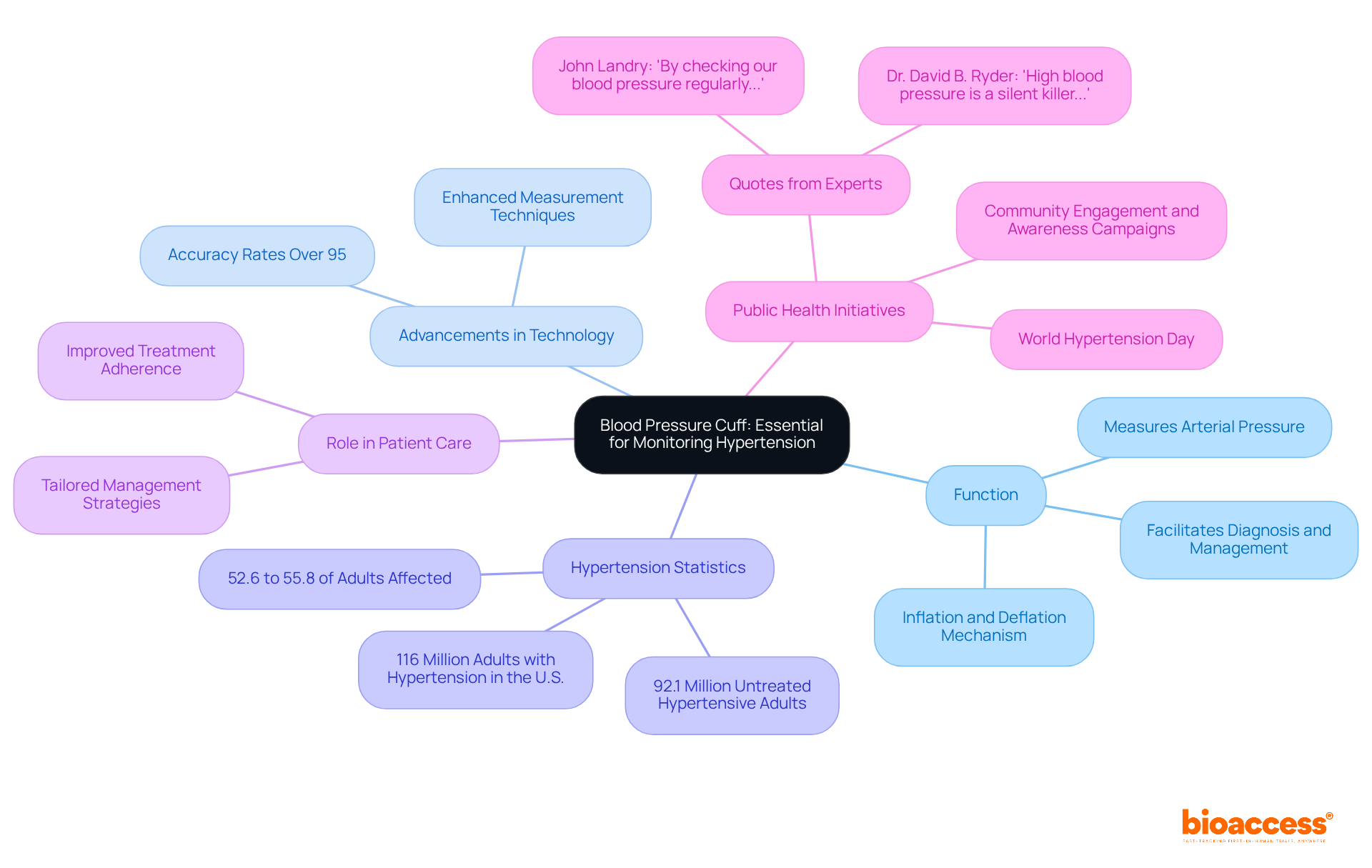
Glucometers are indispensable for individuals with diabetes, facilitating real-time tracking of blood glucose levels. These devices function by analyzing a small blood sample, delivering immediate feedback on glucose concentrations. Consistent oversight empowers patients to efficiently manage their condition, thereby preventing complications such as hypoglycemia or hyperglycemia.
In clinical research, glucometers play a pivotal role in evaluating the efficacy of new diabetes treatments, underscoring their critical importance in diabetes management. The incidence of diabetes has escalated significantly in recent years, primarily due to rising obesity rates and sedentary lifestyles, which further accentuates the need for effective assessment tools.
The American Diabetes Association recommends that most non-pregnant adults with diabetes aim for an A1C level below 7% or 154 mg/dL, thus emphasizing the vital role of precise glucose assessment. Recent studies have scrutinized the accuracy of various glucose meters, including the Contour Next and Accu-Chek Guide, both of which have met stringent accuracy standards, ensuring reliable readings essential for patient safety.
Moreover, continuous glucose monitoring (CGM) technologies are increasingly being integrated into research studies, enhancing data collection and providing deeper insights into individual health. As Clayton M. Christensen notes, equipping individuals with the appropriate tools, which include biomedical devices examples like glucometers, empowers them to manage their diabetes effectively, illustrating the transformative potential of these technologies in clinical settings and daily life.
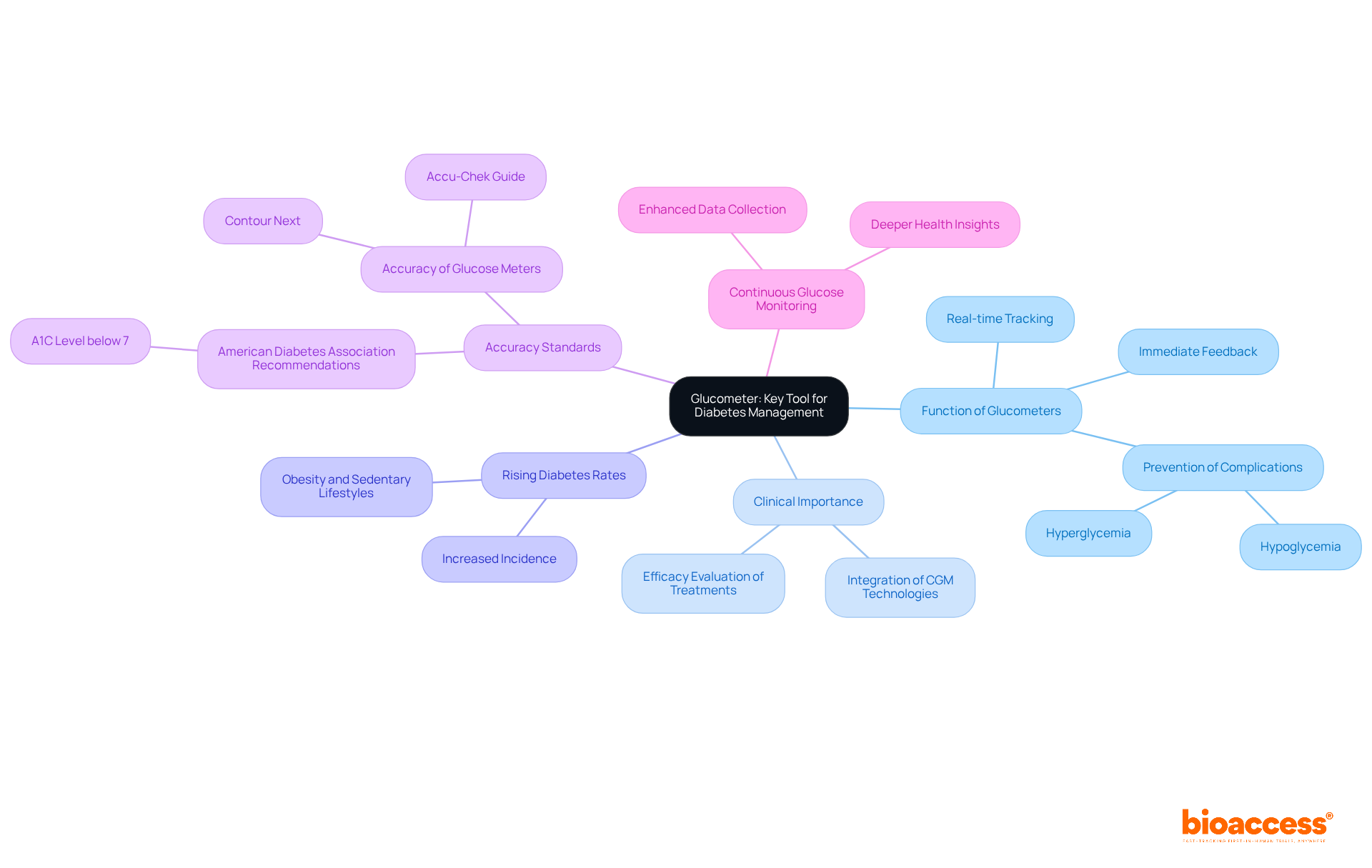
The pulse oximeter serves as a vital non-invasive device, measuring blood oxygen saturation levels through light absorption technology to provide rapid and precise readings. This capability is particularly crucial for individuals with respiratory conditions or those undergoing anesthesia, where maintaining optimal oxygen levels is essential. In research environments, pulse oximeters play an indispensable role in monitoring safety during trials, ensuring that oxygen saturation remains within safe limits.
Their precision is paramount; while manufacturers assert a precision of 2%, evaluations frequently reveal an error range of 3% to 4%, especially in severely ill individuals. This discrepancy underscores the necessity for thorough calibration and monitoring protocols, which are integral to the comprehensive trial management services provided by bioaccess, encompassing feasibility studies and project management. Furthermore, the FDA's recent proposals highlight the importance of including diverse individuals in research studies, mandating that at least 25% of participants have darker skin tones to enhance the reliability of pulse oximetry readings across various demographics.
Additionally, the FDA has instituted guidelines requiring the collection of 3,000 data points for pulse oximeter calibration, emphasizing the regulatory changes that impact the precision and dependability of these instruments in medical settings. Consequently, pulse oximeters not only facilitate prompt patient care but also play a critical role in upholding the integrity of research trials, ensuring that patient safety is prioritized throughout the research process. Researchers in the medical field are encouraged to advocate for the use of calibrated devices and to ensure diverse representation in their studies, aligning with the comprehensive services offered by bioaccess to support successful trials.
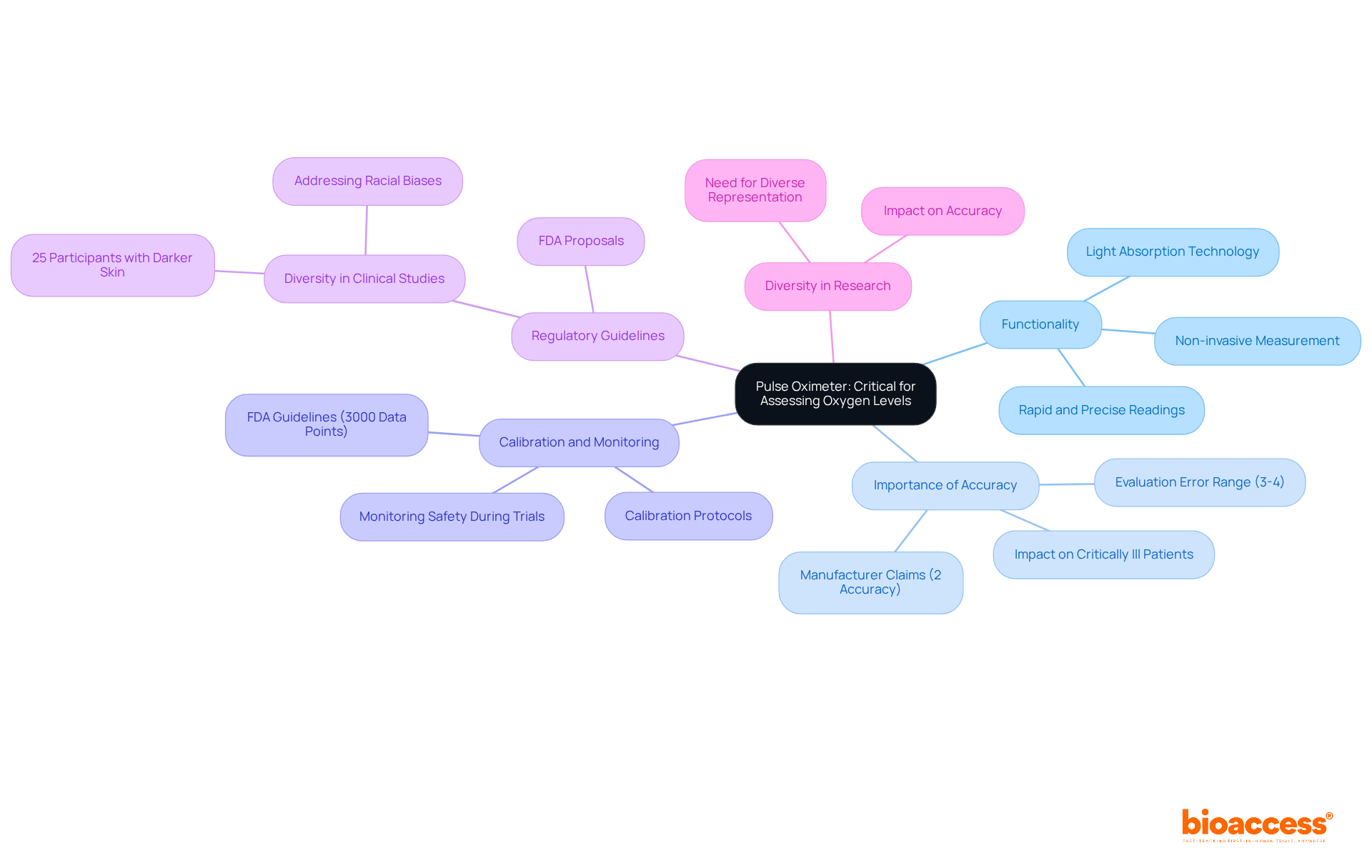
The integration of biomedical devices examples like an electrocardiogram (ECG) and a stethoscope is crucial for comprehensive cardiac health monitoring. The ECG captures the heart's electrical activity, providing essential data for diagnosing conditions such as arrhythmias and myocardial injury. Meanwhile, the stethoscope enables clinicians to auscultate heart sounds, offering additional insights into cardiac function. This dual approach is particularly significant in clinical trials, where the accurate assessment of new cardiac therapies' safety and efficacy is paramount.
Recent advancements indicate that wearable ECG devices are among the biomedical devices examples that can detect cardiovascular events up to an hour before they occur, showcasing their potential in proactive health management. Notably, biomedical devices examples like smartwatches and portable ECGs exhibit sensitivity levels exceeding 90% for detecting atrial fibrillation (AFib). Additionally, research has shown that hospitals employing AI and wearable technology have experienced a 33.1% reduction in heart failure cases and a 20-30% increase in medication adherence. This highlights the effectiveness of these tools in enhancing outcomes for individuals.
Together, the ECG and stethoscope not only enhance diagnostic precision but also facilitate the development of personalized treatment plans, ultimately advancing cardiac care. As Dr. Nishat Tamanna noted, "Hospitals need to start using new noninvasive digital health tools if they want to better monitor their individuals and detect cardiovascular events before they occur.

Wearable health gadgets, such as fitness trackers and smartwatches, are revolutionizing ongoing health assessment, providing numerous biomedical devices examples. Examples of biomedical devices include those that monitor a range of metrics, such as:
These devices deliver vital insights for both individuals and healthcare professionals. In the realm of clinical research, wearables facilitate remote observation of participants, enhancing data collection and boosting participant engagement. Their capability to provide real-time feedback empowers individuals to take charge of their health, establishing them as indispensable tools in contemporary medicine.
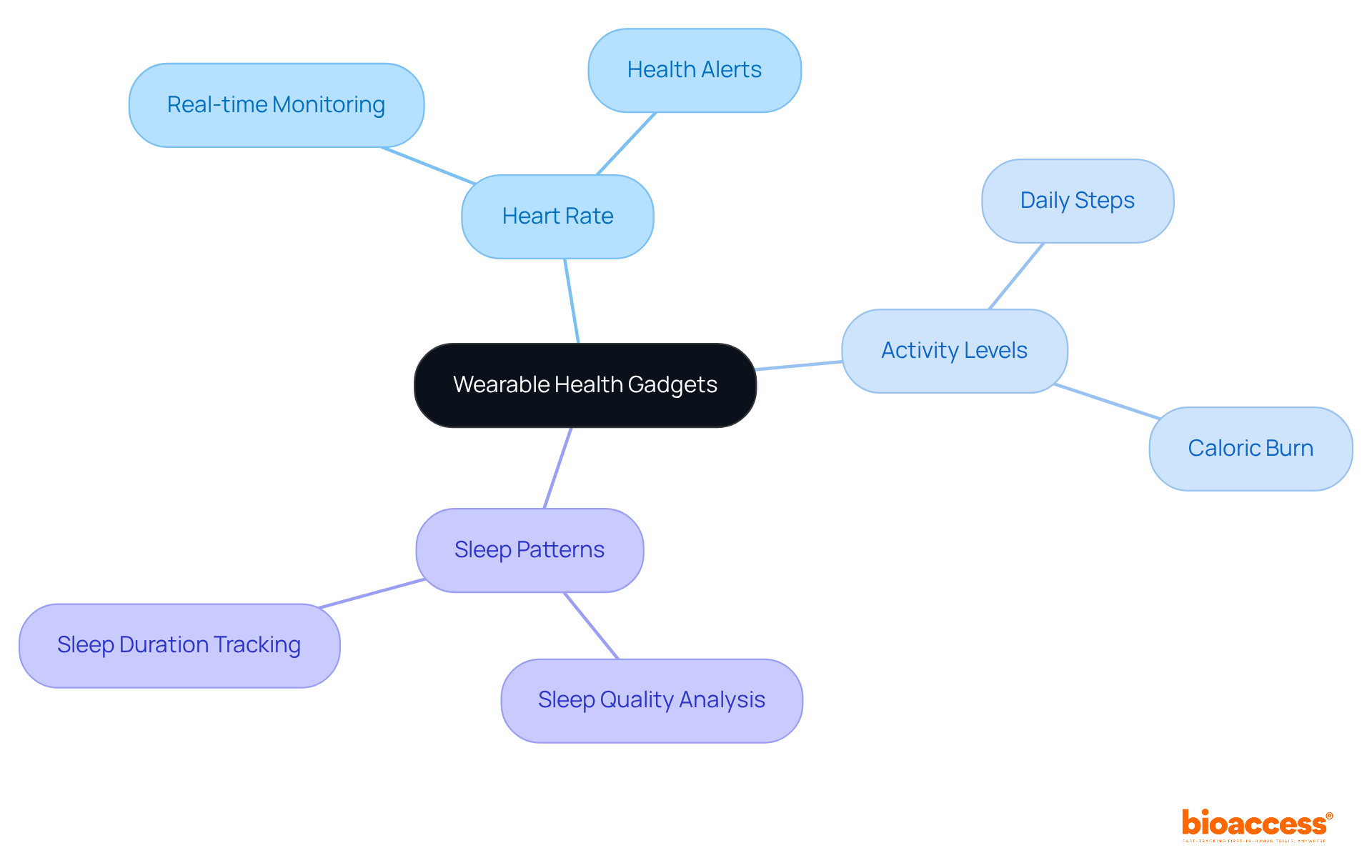
The thermometer is an essential medical device, pivotal for measuring body temperature—a vital sign in health assessments. Precise temperature measurements are crucial for diagnosing infections and evaluating patient health, as variations can indicate underlying conditions. Various types of thermometers, including digital and infrared models, provide quick and reliable results, with digital thermometers typically lasting about 3-5 years.
It is imperative to consult manufacturers regarding suggested replacement frequency to ensure optimal performance. In medical research, thermometers play a critical role in monitoring participants' health conditions, enabling prompt action when deviations from normal temperature ranges occur.
For instance, a systematic review revealed that peripheral thermometers can underestimate core temperature by as much as 1 °C, highlighting the necessity for precise measurement tools. Furthermore, medical thermometers must comply with ASTM standards, ensuring accuracy within a tolerance of +/-0.2°C.
This device remains a cornerstone of health evaluation in both medical and home settings, empowering healthcare professionals to make informed decisions based on accurate data while also adhering to hygiene standards in thermometer design.
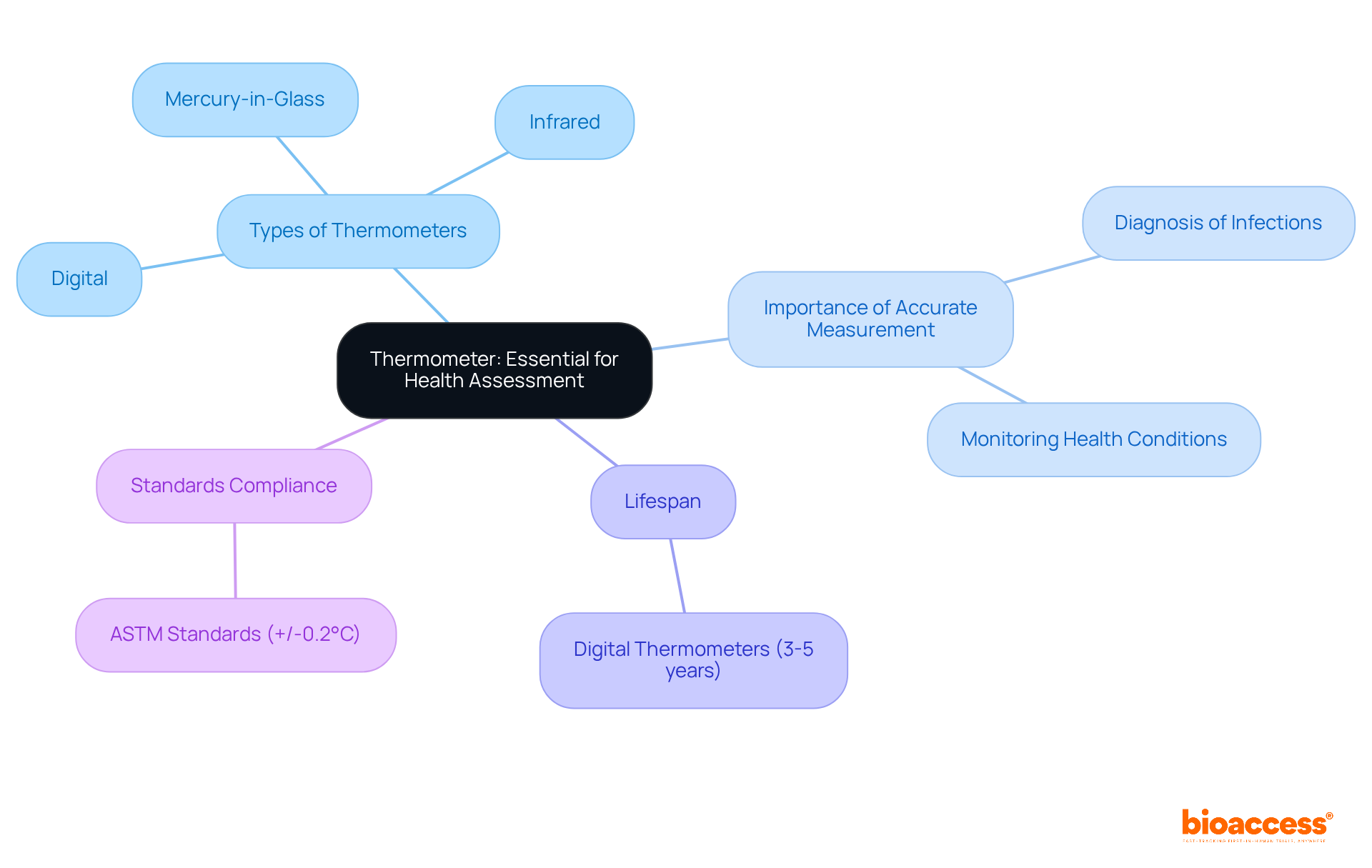
Scales are indispensable for tracking patients' weight, a key indicator of health status. Regular weight assessments are crucial for identifying issues such as obesity, malnutrition, or fluid retention. In medical environments, precise weight measurements are vital for administering medications and evaluating treatment effectiveness. Furthermore, scales are utilized in research to assess the impact of interventions on weight management, establishing their significance in health monitoring.
With over 100 million Americans part of the employer-sponsored population, the importance of effective weight management is underscored. The integration of advanced weight management devices, such as digital scales that provide real-time data, can significantly enhance the accuracy and reliability of these assessments.
Quotes from healthcare experts emphasizing the necessity of accurate weight measurements in research studies lend further authority to this discussion. Moreover, specific biomedical devices examples used in medical research, such as bioelectrical impedance analysis scales or smart scales that monitor body composition, provide practical insights for researchers.
Incorporating these advanced tools and methodologies not only improves outcomes for individuals but also ensures that weight assessments substantially influence research results. Healthcare providers should consider adopting digital scales that connect with health applications to streamline data gathering and enhance engagement in their weight management journey.
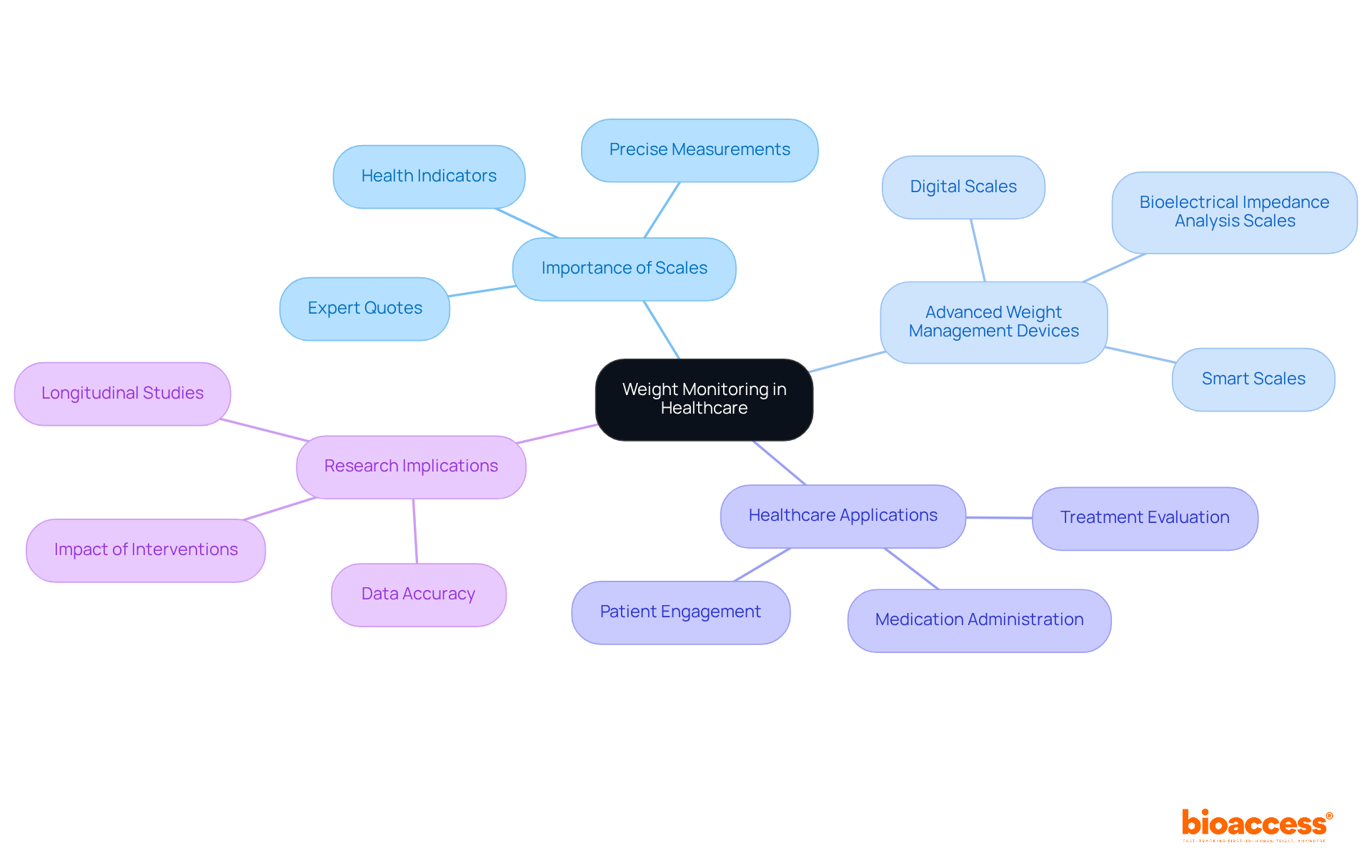
Remote health monitoring (RPM) tools empower healthcare professionals to oversee individuals' health information beyond traditional clinical environments. These devices meticulously track vital signs, medication adherence, and various health metrics, facilitating timely interventions and fostering greater engagement among individuals.
For example:
In the realm of clinical research, RPM enhances data collection and participant retention, streamlining the evaluation of new treatments. This technology is particularly vital for chronic disease management, where continuous observation can lead to improved health outcomes.
By 2025, it is projected that approximately 71 million Americans will be using some form of remote health monitoring service, further revolutionizing care and establishing it as a crucial component of modern healthcare delivery.
However, challenges such as increased workload stemming from vast amounts of patient data and privacy concerns must also be addressed to fully harness the potential of RPM.
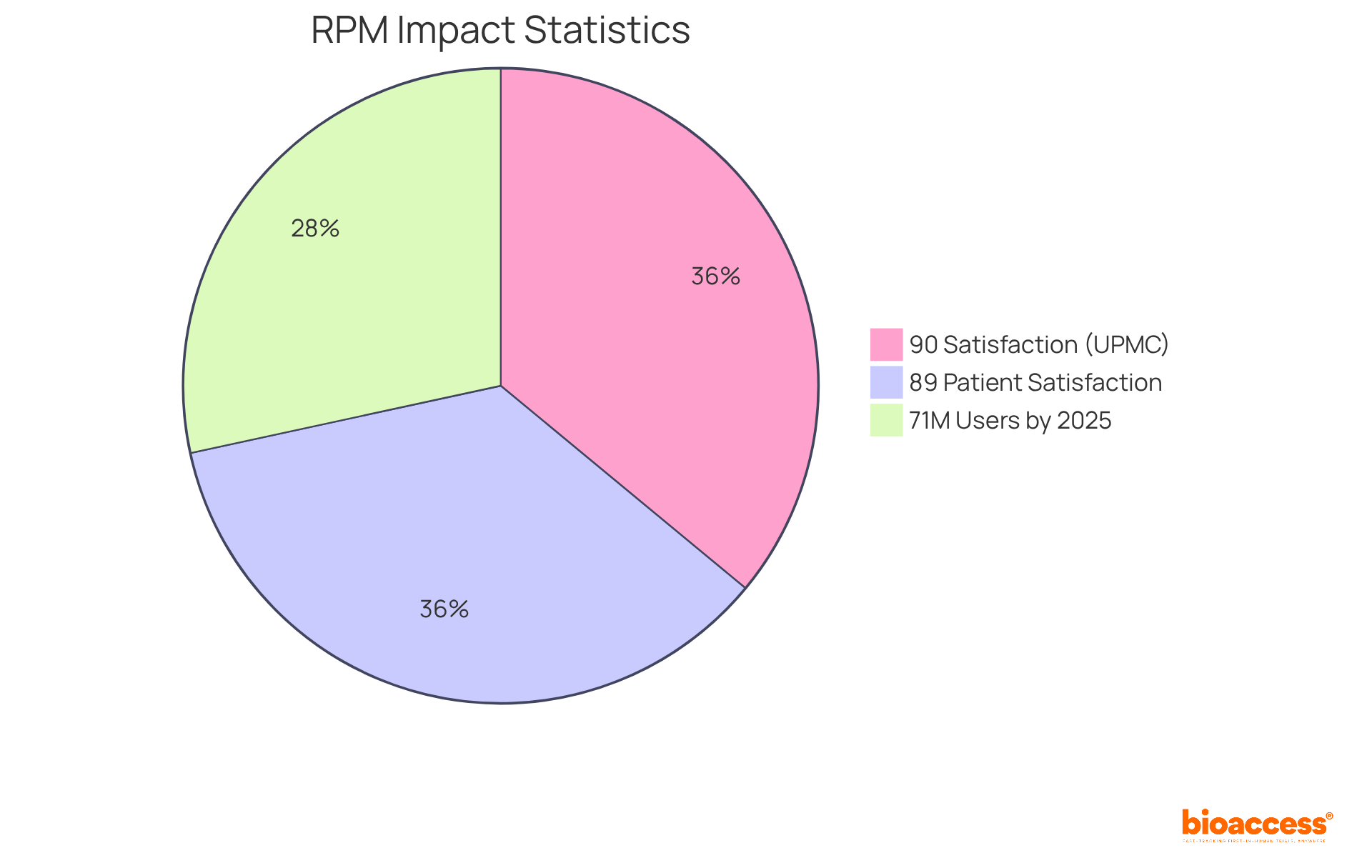
The World Health Organization (WHO) plays a pivotal role in advancing biomedical technology through extensive research, guidelines, and innovative practices. WHO initiatives are designed to enhance access to essential medical tools, improve safety standards, and promote the integration of technology in healthcare delivery. Notably, the latest WHO guidelines for 2025 underscore the significance of equitable access to medical technologies, with the objective of bridging healthcare system gaps globally. Alarmingly, statistics reveal that approximately 2 billion individuals lack access to essential health services, highlighting an urgent demand for effective medical equipment.
By fostering collaboration among countries and stakeholders, WHO innovations significantly enhance health outcomes worldwide. The impact of these advancements is particularly evident in various regions, where improved access to medical devices has resulted in reduced mortality rates from preventable diseases. For instance, the advent of portable diagnostic tools has transformed disease detection in remote areas, facilitating timely interventions.
As healthcare professionals and researchers endeavor to elevate patient care, it is crucial to comprehend these advancements and the WHO's influential role in shaping medical technology. The ongoing commitment to enhancing access and safety standards will persist in driving progress in global health, ultimately benefiting populations in need.
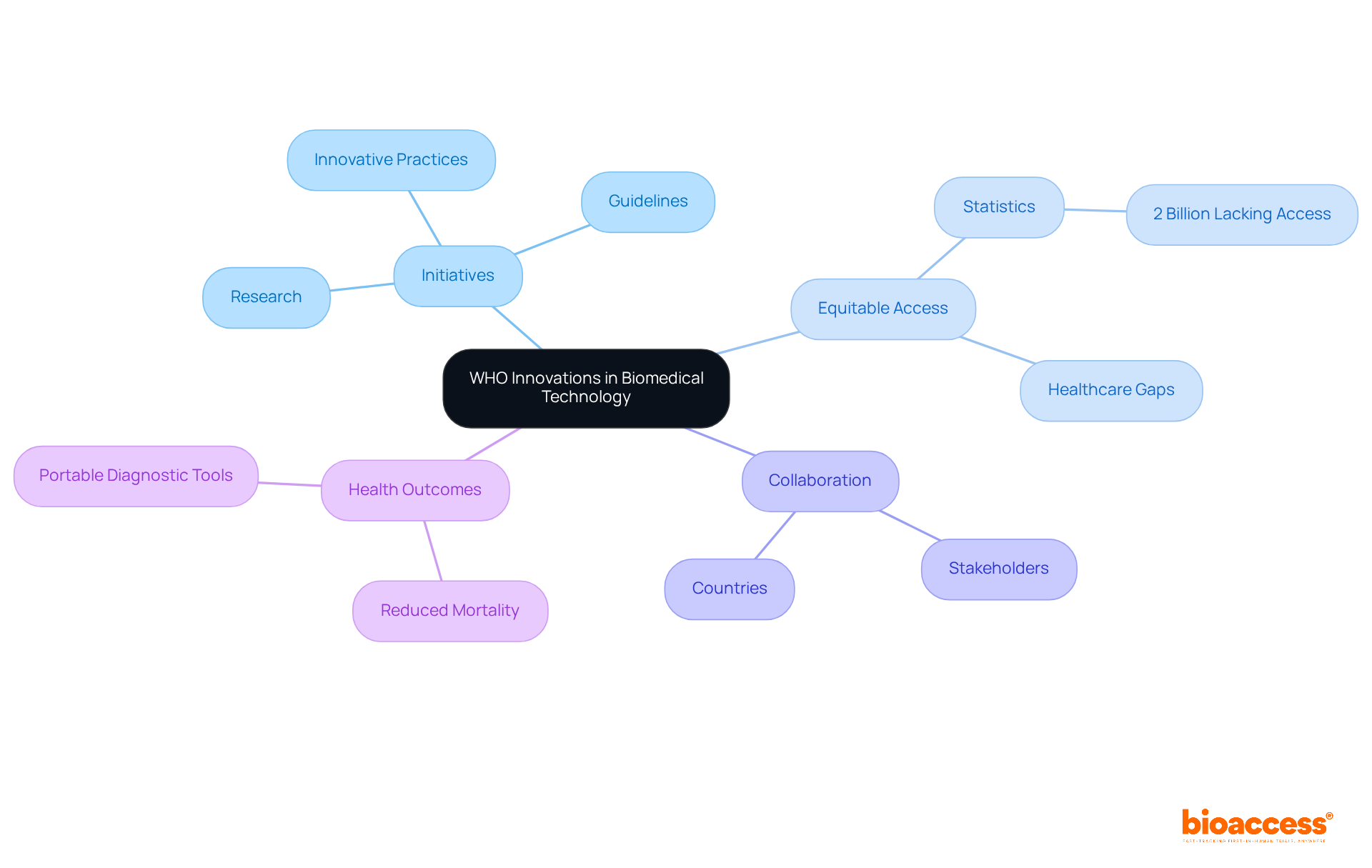
The exploration of essential biomedical devices underscores their critical role in enhancing clinical research and patient care. By integrating advanced technologies and innovative solutions, these devices not only facilitate accurate monitoring and diagnosis but also streamline the research process, ultimately leading to improved health outcomes. This commitment to advancing these technologies reflects a broader dedication to patient safety and efficacy in medical practices.
Throughout the article, various examples of biomedical devices, including:
are highlighted for their unique contributions to both clinical settings and research environments. Each device plays a vital role in gathering data, ensuring accurate assessments, and supporting healthcare professionals in making informed decisions. The advancements in these technologies are paving the way for more efficient clinical trials and better patient management strategies.
As the landscape of healthcare continues to evolve, the importance of leveraging innovative biomedical devices cannot be overstated. Embracing these advancements is essential for healthcare providers and researchers alike, as they strive to improve patient experiences and outcomes. By prioritizing the integration of these tools into clinical practice and research, a significant impact on public health can be achieved, ultimately leading to a healthier future for all.
What is bioaccess® and what role does it play in clinical research?
bioaccess® accelerates clinical research for medical devices by utilizing the regulatory speed of Latin America, diverse patient populations in the Balkans, and efficient ethical approval pathways in Australia, achieving approvals in 4-6 weeks.
How does bioaccess® benefit Medtech, Biopharma, and Radiopharma innovators?
It enables these innovators to expedite their research studies, achieving enrollment rates that are 50% faster than traditional markets.
What expertise does bioaccess® offer for early-phase studies?
With over 15 years of specialized expertise, bioaccess® provides tailored solutions to facilitate rapid and efficient market entry for biomedical devices.
Why is the blood pressure cuff important in clinical settings?
The blood pressure cuff is vital for measuring arterial pressure, diagnosing, and managing hypertension, influencing treatment plans and patient outcomes.
How does a blood pressure cuff work?
It inflates around the upper arm to temporarily obstruct blood flow, then measures the pressure as it deflates.
What advancements have been made in blood pressure cuff technology by 2025?
Many blood pressure cuffs now achieve over 95% accuracy in clinical environments, improving hypertension management.
What percentage of adults exhibit elevated blood pressure or stage 1 hypertension?
Between 52.6% to 55.8% of adults aged 20 years and older show elevated blood pressure or stage 1 hypertension.
How do blood pressure cuffs contribute to medical research?
They enable the collection of real-time data that aids in evaluating new therapeutic interventions.
What is the significance of regular blood pressure monitoring?
Regular checks can help tackle hypertension, preventing complications like heart attacks and strokes, and are emphasized in public health initiatives like World Hypertension Day.
What role do glucometers play in diabetes management?
Glucometers allow individuals with diabetes to track their blood glucose levels in real-time, helping to prevent complications such as hypoglycemia or hyperglycemia.
How do glucometers function?
They analyze a small blood sample to provide immediate feedback on glucose concentrations.
What is the American Diabetes Association's recommendation for A1C levels in non-pregnant adults with diabetes?
They recommend aiming for an A1C level below 7% or 154 mg/dL.
What is the significance of continuous glucose monitoring (CGM) technologies in research?
CGM technologies enhance data collection and provide deeper insights into individual health, contributing to more effective diabetes management.
How have recent studies evaluated glucometer accuracy?
Studies have scrutinized various glucose meters, ensuring they meet stringent accuracy standards for reliable readings essential for patient safety.